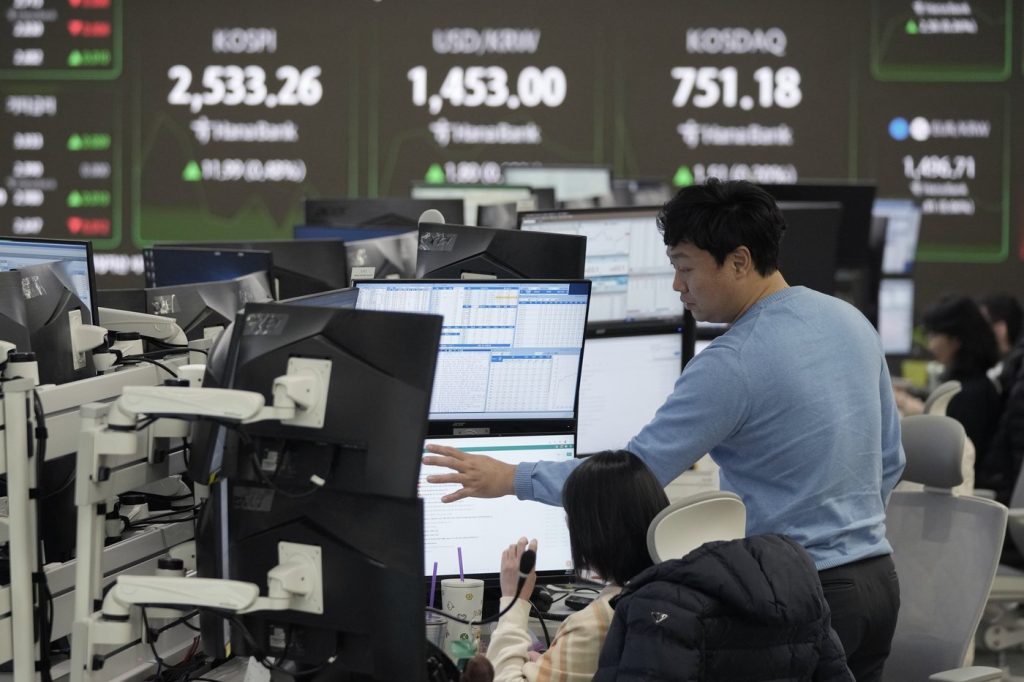HONG KONG (AP) — Asian stocks experienced a downward trend on Tuesday following the announcement of a 25% tariff on all U.S. imports of steel and aluminum by U.S. President Donald Trump. In Hong Kong, the Hang Seng index fell 0.62% to close at 21,388.49, while the Shanghai Composite Index saw a slight dip of 0.16%, reaching 3,316.83. Japanese markets remained closed due to a national holiday. Conversely, Australia’s S&P/ASX 200 index showed little change, and South Korea’s KOSPI rose by 0.41%, settling at 2,530.78.
Trump had indicated over the weekend that he would be imposing these tariffs, with additional import duties expected to be revealed later in the week. The ongoing fear surrounding these tariffs has been a significant driver behind the fluctuations seen on Wall Street, with analysts predicting further market volatility in the near future. Notably, the price of gold, often seen as a safe haven during times of uncertainty, surged to a new record high of over $2,930 per ounce on Monday.
Despite the tariff announcements, Trump has previously pulled back on similar threats, suggesting that such measures might be used as negotiation tools rather than firm long-term economic policies. For instance, he had earlier withdrawn a planned 25% tariff on Canada and Mexico. In the case of China, Trump has moved forward with a 10% tariff on various Chinese goods, to which China responded with tariffs on U.S. coal, liquefied natural gas, crude oil, agricultural machinery, and large-engine vehicles.
According to Vishnu Varathan, head of macro research at Mizuho, China’s limited response indicates a strategic choice to avoid escalating trade tensions further. Nonetheless, he emphasized that U.S.-China trade disputes are likely to intensify, even as a negotiated resolution could be the ultimate goal of Trump’s tariff strategies.
In the United States, market performance remained bullish on Monday. The S&P 500 increased by 40.45 points, reaching 6,066.44. The Dow Jones Industrial Average climbed by 167.01 points, closing at 44,4701.41, while the Nasdaq composite saw a significant rise of 190.87 points to 19,714.27.
In bond trading, the yield on the 10-year Treasury note remained stable at 4.50%, a position it maintained since late Friday. Conversely, the yield on the two-year Treasury, which is more sensitive to changes in monetary policy, slipped to 4.27%, down from 4.29%. Previously, the Federal Reserve had cut its main interest rate multiple times through late 2023, but traders have begun to adjust their expectations regarding further rate cuts in 2025, largely due to concerns about inflation from tariffs. While lower interest rates can stimulate economic activity and asset prices, they may also contribute to rising inflation.
Fed Chair Jerome Powell is scheduled to testify before Congress later this week, where he may offer insights regarding the Federal Reserve’s monetary policy plans. Last December, comments from Fed officials led to a significant market downturn after they suggested only two rate cuts might occur that year.
In energy markets, benchmark U.S. crude oil prices saw an increase of 16 cents, reaching $72.48 per barrel. Internationally, Brent crude oil also rose, gaining 21 cents to reach $76.08 per barrel.
On the currency front, the U.S. dollar showed minimal movements, remaining around 152.02 Japanese yen. The euro also remained stable at approximately $1.03.










